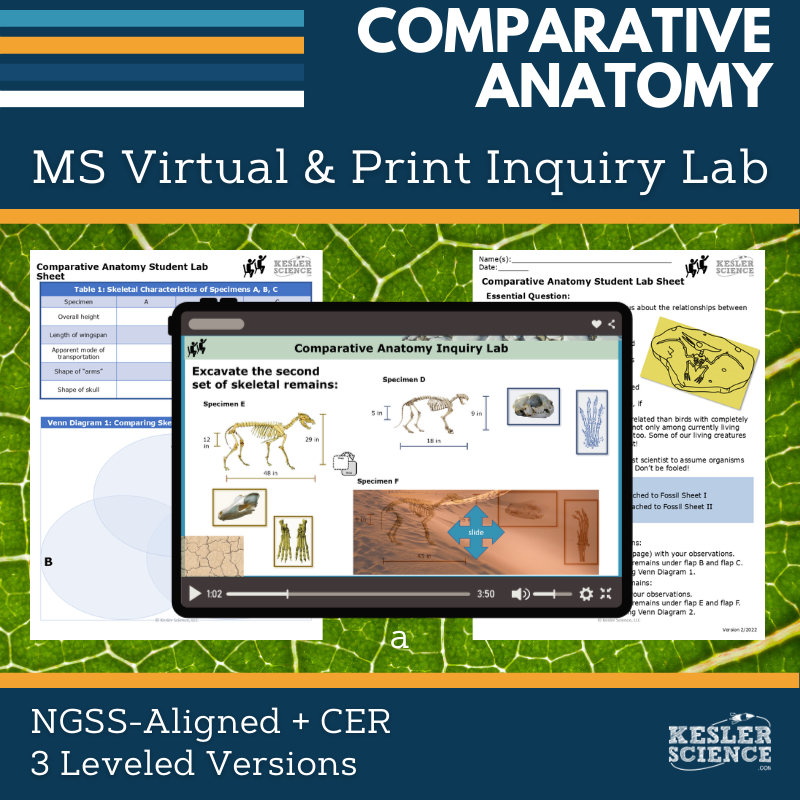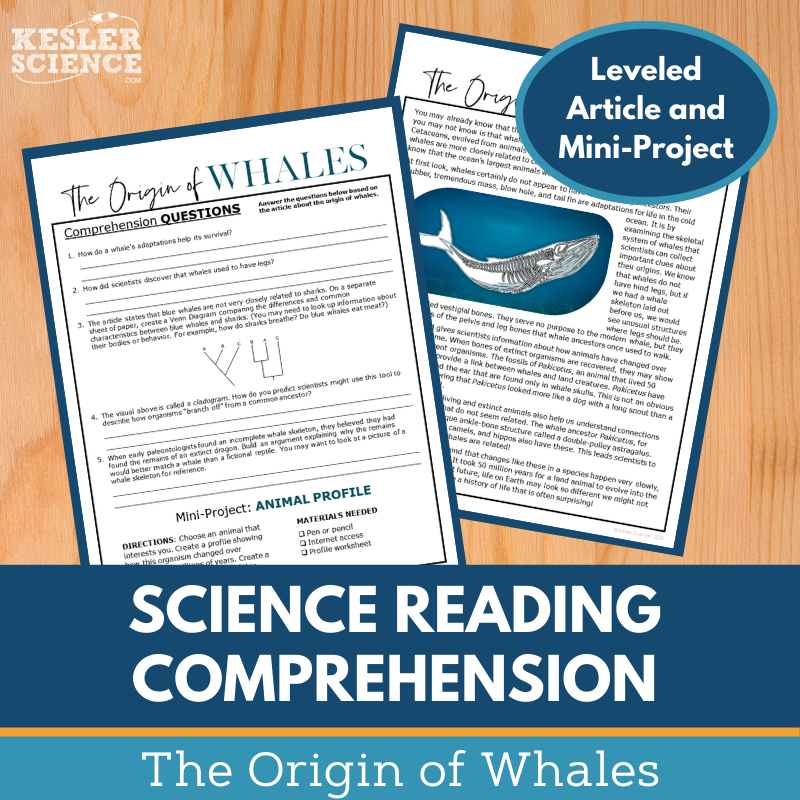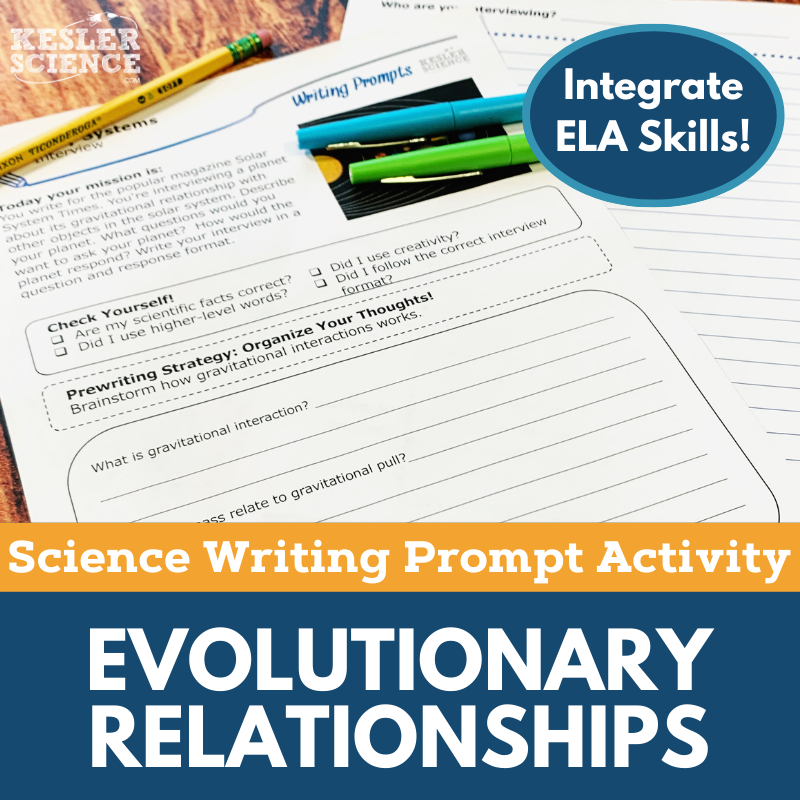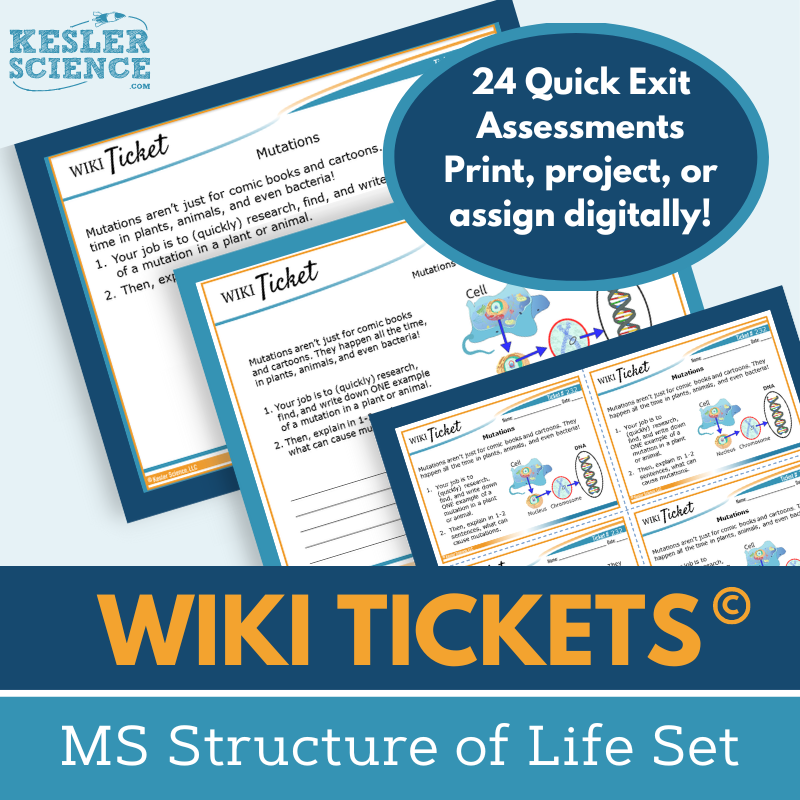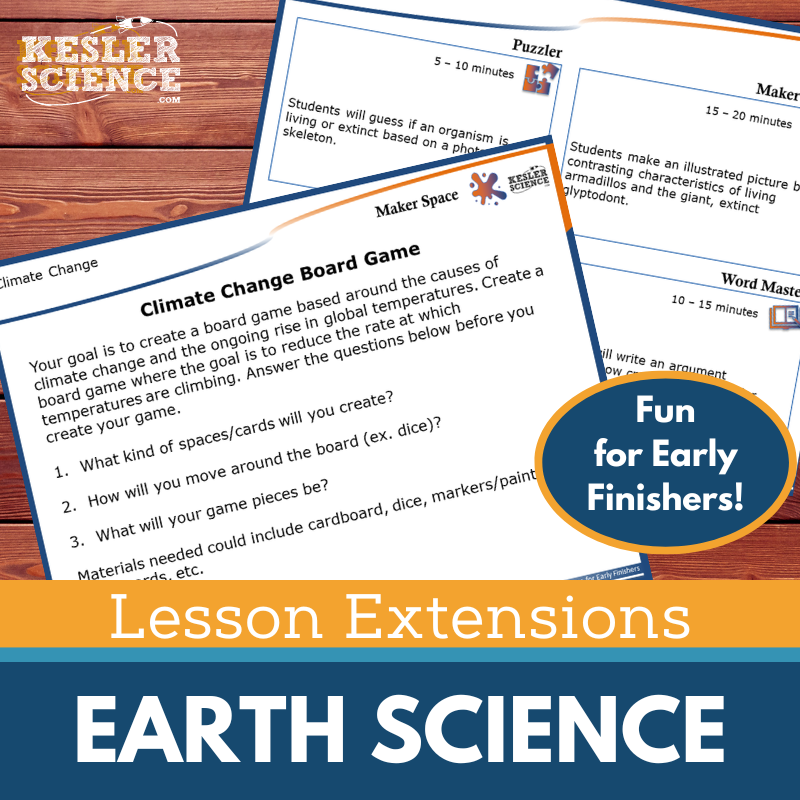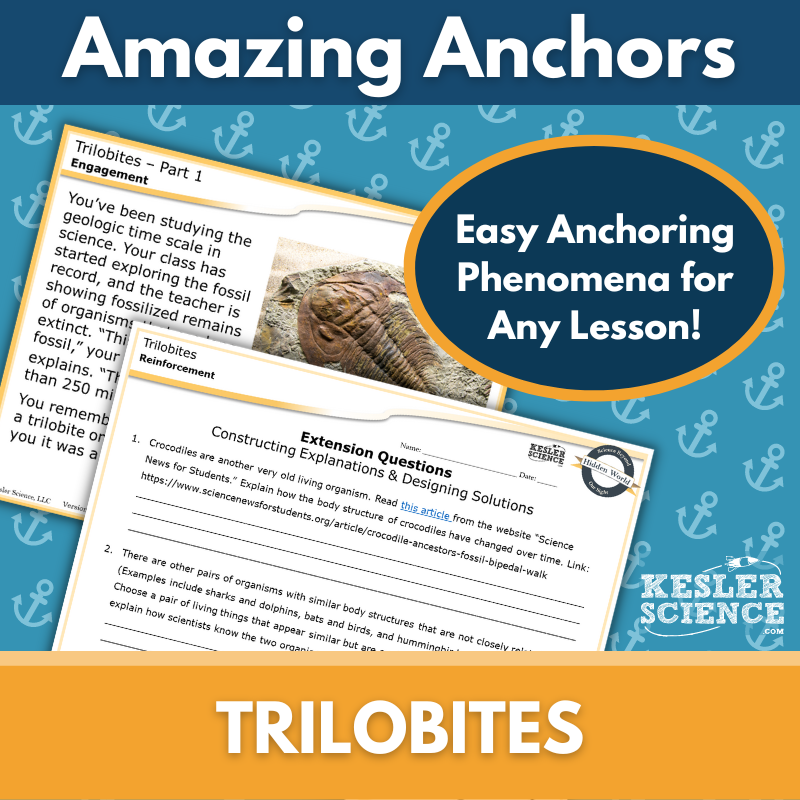Comparative Anatomy Activities for Middle School Science
Aligned with NGSS MS-LS4-2, these lessons engage students in exploring evolutionary relationships by analyzing anatomical similarities and differences between modern and fossil organisms. The resources below will give students a comprehensive understanding of comparative anatomy. All of the following materials are also included in the Kesler Science Membership.
The Comparative Anatomy Inquiry Lab aligns with NGSS MS-LS4-2, guiding students to analyze anatomical similarities and differences between modern and fossil organisms to infer evolutionary relationships. In this lab, students act as paleontologists, excavating and comparing the skeletal structures of one prehistoric and two modern winged animals.
This resource offers both digital and print formats, providing flexibility for hands-on or virtual learning. The digital version, compatible with Google Slides and learning management systems, includes interactive activities requiring no materials. The print version involves hands-on procedures where students work with fossil sheets and scissors.
Differentiation is built in with three levels of difficulty. The Dependent version balances procedural instructions with guided inquiry, the Modified version offers structured support with sentence stems and multiple-choice questions, and the Independent version encourages student-led exploration.
Editable PowerPoints allow customization, and the resource includes teacher pages with standards, objectives, materials, and answer keys. Reflection questions and C.E.R. prompts support student understanding and scientific reasoning.
The Comparative Anatomy Inquiry Lab aligns with NGSS MS-LS4-2, guiding students to analyze anatomical similarities and differences between modern and fossil organisms to infer evolutionary relationships. In this lab, students act as paleontologists, excavating and comparing the skeletal structures of one prehistoric and two modern winged animals.
This resource offers both digital and print formats, providing flexibility for hands-on or virtual learning. The digital version, compatible with Google Slides and learning management systems, includes interactive activities requiring no materials. The print version involves hands-on procedures where students work with fossil sheets and scissors.
Differentiation is built in with three levels of difficulty. The Dependent version balances procedural instructions with guided inquiry, the Modified version offers structured support with sentence stems and multiple-choice questions, and the Independent version encourages student-led exploration.
Editable PowerPoints allow customization, and the resource includes teacher pages with standards, objectives, materials, and answer keys. Reflection questions and C.E.R. prompts support student understanding and scientific reasoning.
This lesson engages middle school students in studying anatomical similarities and differences among modern and fossil organisms to infer evolutionary relationships. Through a nonfiction article on the origin of whales, students answer comprehension questions and research three related animals to create a profile.
Designed for grades 6-8 (and advanced 5th graders), the resource includes two leveled passages (Lexile 1100-1300), five to seven comprehension questions, and a hands-on mini-project. A Cornell notes template is provided. The materials feature engaging graphics that print well in grayscale.
Suitable for in-person or virtual learning, the resource is compatible with Google Classroom, MS Teams, Schoology, and Canvas. Students can complete activities digitally using a PowerPoint file or Google Slides.
This resource is ideal for sub plans, extra credit, ISS, or whole-class instruction, fostering critical thinking, science literacy, and classroom discussions while strengthening reading comprehension skills.
This lesson engages middle school students in studying anatomical similarities and differences among modern and fossil organisms to infer evolutionary relationships. Through a nonfiction article on the origin of whales, students answer comprehension questions and research three related animals to create a profile.
Designed for grades 6-8 (and advanced 5th graders), the resource includes two leveled passages (Lexile 1100-1300), five to seven comprehension questions, and a hands-on mini-project. A Cornell notes template is provided. The materials feature engaging graphics that print well in grayscale.
Suitable for in-person or virtual learning, the resource is compatible with Google Classroom, MS Teams, Schoology, and Canvas. Students can complete activities digitally using a PowerPoint file or Google Slides.
This resource is ideal for sub plans, extra credit, ISS, or whole-class instruction, fostering critical thinking, science literacy, and classroom discussions while strengthening reading comprehension skills.
The Evolutionary Relationships Science Writing Prompt Activity engages middle school students in a compare-and-contrast essay to reinforce their understanding of life science concepts. Aligned with MS-LS4-2, this activity helps students apply scientific ideas to analyze anatomical similarities and differences among modern and fossil organisms to infer evolutionary relationships. Designed for both in-person and virtual learning, it enhances science reasoning and writing skills in an interactive format.
This resource includes teacher directions with an answer guide, project ideas, and rubrics, as well as projection and print handouts in both full-sized and half-sheet formats. A digital interactive version is available in PowerPoint and Google Slides, making it adaptable for remote learners.
Ideal for cross-curricular activities, pre-test assessments, student choice projects, early finisher tasks, extra credit, make-up work, TELPAS samples, and differentiation, this writing prompt fosters engagement and scientific literacy. It also works well for classroom displays or student anthologies. Because this activity is designed for review, students should have prior knowledge of the topic or access to research materials.
The Evolutionary Relationships Science Writing Prompt Activity engages middle school students in a compare-and-contrast essay to reinforce their understanding of life science concepts. Aligned with MS-LS4-2, this activity helps students apply scientific ideas to analyze anatomical similarities and differences among modern and fossil organisms to infer evolutionary relationships. Designed for both in-person and virtual learning, it enhances science reasoning and writing skills in an interactive format.
This resource includes teacher directions with an answer guide, project ideas, and rubrics, as well as projection and print handouts in both full-sized and half-sheet formats. A digital interactive version is available in PowerPoint and Google Slides, making it adaptable for remote learners.
Ideal for cross-curricular activities, pre-test assessments, student choice projects, early finisher tasks, extra credit, make-up work, TELPAS samples, and differentiation, this writing prompt fosters engagement and scientific literacy. It also works well for classroom displays or student anthologies. Because this activity is designed for review, students should have prior knowledge of the topic or access to research materials.
The WIKI Tickets© Structure of Life Set offers 24 formative assessments designed for 6th-8th grade science, providing flexible and engaging ways to check student understanding. Each topic is available in five formats: a full-screen projection version, three printable handout sizes, and an interactive digital version compatible with PowerPoint and Google Slides.
Aligned with NGSS and TEKS standards, these assessments cover essential life science topics such as cell function, comparing skeletal structures, heredity, reproduction, levels of cellular organization, and genetic mutations. A bonus table of contents file is included to show standard alignment. These WIKI Tickets© can be used for in-person or virtual learning, making them versatile for any classroom setting. Students can respond on paper, digitally, or in a remote 1:1 environment. Use them as exit tickets, bellringers, or quick checks to assess student progress effectively.
The WIKI Tickets© Structure of Life Set offers 24 formative assessments designed for 6th-8th grade science, providing flexible and engaging ways to check student understanding. Each topic is available in five formats: a full-screen projection version, three printable handout sizes, and an interactive digital version compatible with PowerPoint and Google Slides.
Aligned with NGSS and TEKS standards, these assessments cover essential life science topics such as cell function, comparing skeletal structures, heredity, reproduction, levels of cellular organization, and genetic mutations. A bonus table of contents file is included to show standard alignment. These WIKI Tickets© can be used for in-person or virtual learning, making them versatile for any classroom setting. Students can respond on paper, digitally, or in a remote 1:1 environment. Use them as exit tickets, bellringers, or quick checks to assess student progress effectively.
Lesson Extensions provide engaging, student-choice activities designed to challenge early finishers and deepen their understanding of earth science standards. These activities help fill downtime, reinforce critical thinking, and keep students engaged with rigorous yet enjoyable learning opportunities. Aligned to NGSS and TEKS, they offer flexible, high-level resources that support independent learning and enrichment.
Each extension includes four interactive components: Puzzler for problem-solving, Maker Space for hands-on STEAM activities, Tech Connection for digital demonstrations, and Word Master for creative writing. With teacher directions, answer keys, and both print and projection versions, these extensions are perfect for lesson wrap-ups, enrichment, or independent challenges.
Topics covered include climate and circulation, plate tectonics, fossil records, geological time scales, natural hazards, and more, ensuring students explore essential earth science concepts in a meaningful and engaging way.
Lesson Extensions provide engaging, student-choice activities designed to challenge early finishers and deepen their understanding of earth science standards. These activities help fill downtime, reinforce critical thinking, and keep students engaged with rigorous yet enjoyable learning opportunities. Aligned to NGSS and TEKS, they offer flexible, high-level resources that support independent learning and enrichment.
Each extension includes four interactive components: Puzzler for problem-solving, Maker Space for hands-on STEAM activities, Tech Connection for digital demonstrations, and Word Master for creative writing. With teacher directions, answer keys, and both print and projection versions, these extensions are perfect for lesson wrap-ups, enrichment, or independent challenges.
Topics covered include climate and circulation, plate tectonics, fossil records, geological time scales, natural hazards, and more, ensuring students explore essential earth science concepts in a meaningful and engaging way.
This Amazing Anchors Phenomenon Lesson introduces evolutionary relationships through an engaging, real-world connection. It features an introductory reading on trilobites with comprehension and extension questions to prepare students for deeper learning, followed by an explanatory reading that breaks down the science behind relationships between modern and fossil organisms. Additional comprehension and reinforcement questions further student understanding.
Aligned with NGSS standard LS4-2, this no-prep resource includes teacher directions with answer keys, projection slides, editable digital formats for LMS platforms, and printable full- and half-sheet handouts. A differentiated version supports students with sentence starters and modified language. Designed to bookend a lesson, these readings serve as effective supplements for the Engagement and Elaborate segments of 5E lessons, making them ideal for both in-person and digital classrooms.
This Amazing Anchors Phenomenon Lesson introduces evolutionary relationships through an engaging, real-world connection. It features an introductory reading on trilobites with comprehension and extension questions to prepare students for deeper learning, followed by an explanatory reading that breaks down the science behind relationships between modern and fossil organisms. Additional comprehension and reinforcement questions further student understanding.
Aligned with NGSS standard LS4-2, this no-prep resource includes teacher directions with answer keys, projection slides, editable digital formats for LMS platforms, and printable full- and half-sheet handouts. A differentiated version supports students with sentence starters and modified language. Designed to bookend a lesson, these readings serve as effective supplements for the Engagement and Elaborate segments of 5E lessons, making them ideal for both in-person and digital classrooms.
Year-Round Resources
These year-round activities will increase your students' understanding of many middle school science topics. All of these activities are also included in the Kesler Science Membership.
Visual Data & Graphing
You're not alone if your students struggle with understanding graphs, charts, and tables. It's a skill that takes an enormous amount of practice. This resource will help students build a strong foundation in analyzing data and creating their own data visualizations.
Bell Ringers and Warm-Ups
These middle school science bell ringers are an excellent way to engage your students as soon as they walk into your classroom. This comprehensive FULL YEAR resource includes everything you need to start off each science class with an interesting warm-up activity.
Review Board Games
Each game board has been carefully designed to keep students engaged. There are 10 different action spaces on each board and dozens of question cards. All of the actions are related to science concepts and keep the students motivated throughout the game.
Each game is ready to play. Simply print out the board and the cards and let the students enjoy reviewing nine different units.
Essential Questions and Standards
Below are the essential questions and standards associated with the lessons and activities included in the comparative anatomy unit. This topic is only one of more than 100 middle school science topics included in the Kesler Science Membership.
-
What can the structure of a skeleton tell us about the relationships between organisms?
-
NGSS - MS-LS4-2 Comparative Anatomy
Kesler Science Membership
Imagine never having to search for another middle school science lesson again. The membership gives you access to ALL of the Kesler Science products in one place (Yes, including everything above).
Say goodbye to long hours of lesson prep.

